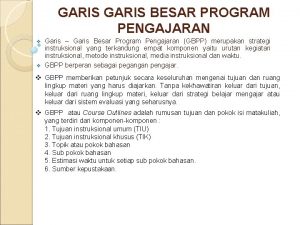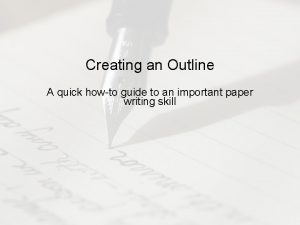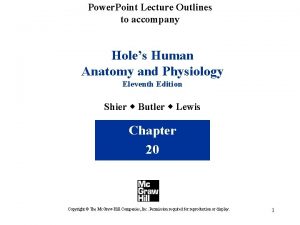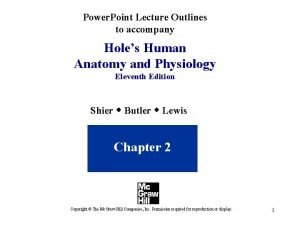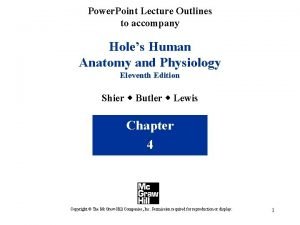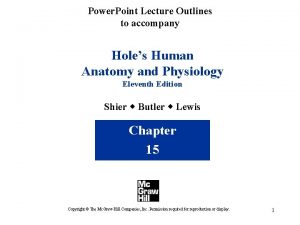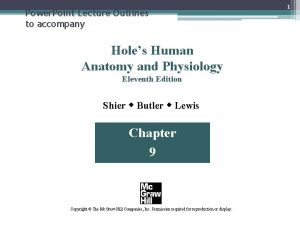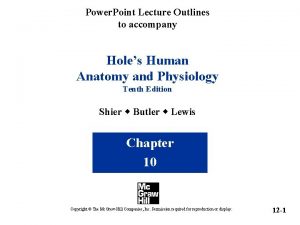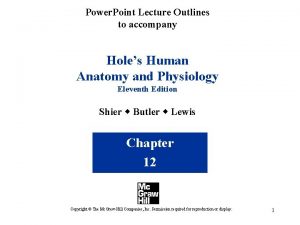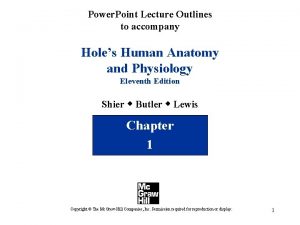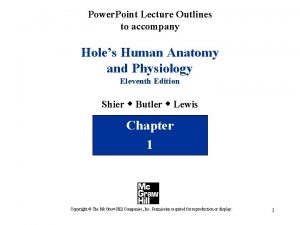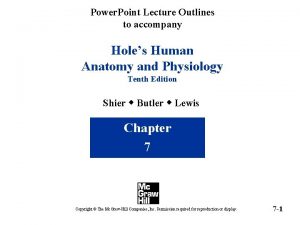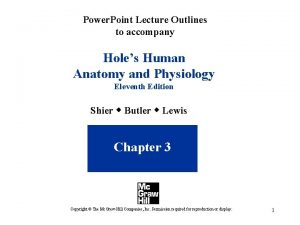Power Point Lecture Outlines to accompany Holes Human













- Slides: 13

Power. Point Lecture Outlines to accompany Hole’s Human Anatomy and Physiology Shier w Butler w Lewis Chapter 5 Copyright © The Mc. Graw-Hill Companies, Inc. Permission required for reproduction or display. 1

Connective Tissues General characteristics - • most abundant tissue type • many functions • bind structures • provide support and protection • serve as frameworks • fill spaces • store fat • produce blood cells • protect against infections • help repair tissue damage • have a matrix • have varying degrees of vascularity • have cells that usually divide 2

Connective Tissue Major Cell Types Fibroblasts • fixed cell • most common cell • large, star-shaped • produce fibers Macrophages • wandering cell • phagocytic • important in injury or infection Mast cells • fixed cell • release heparin • release histamine 3

Connective Tissue Fibers Collagenous fibers • thick • composed of collagen • great tensile strength • abundant in dense CT • hold structures together • tendons, ligaments Reticular fibers • very thin collagenous fibers • highly branched • form supportive networks Elastic fibers • bundles of microfibrils embedded in elastin • fibers branch • elastic • vocal cords, air passages 4

Connective Tissues Connective tissue proper • loose connective tissue • adipose tissue • reticular connective tissue • dense connective tissue • elastic connective tissue Specialized connective tissue • cartilage • bone • blood 5

Connective Tissues Loose connective tissue • mainly fibroblasts • fluid to gel-like matrix • collagenous fibers • elastic fibers • bind skin to structures • beneath most epithelia • blood vessels nourish nearby epithelial cells • between muscles Adipose tissue • adipocytes • cushions • insulates • store fats • beneath skin • behind eyeballs • around kidneys and heart 6

Connective Tissues Reticular connective tissue • composed of reticular fibers • supports internal organ walls • walls of liver, spleen, lymphatic organs Dense connective tissue • packed collagenous fibers • elastic fibers • few fibroblasts • bind body parts together • tendons, ligaments, dermis • poor blood supply 7

Connective Tissues Elastic connective tissue • abundant in elastic fibers • some collagenous fibers • fibroblasts • attachments between bones • walls of large arteries, airways, heart Bone (Osseous Tissue) • solid matrix • supports • protects • forms blood cells • attachment for muscles • skeleton • osteocytes in lacunae 8

Connective Tissues Hyaline cartilage Cartilage • rigid matrix • chondrocytes in lacunae • poor blood supply • three types • hyaline • elastic • fibrocartilage • most abundant • ends of bones • nose, respiratory passages • embryonic skeleton Elastic cartilage • flexible • external ear, larynx Fibrocartilage • very tough • shock absorber • intervertebral discs • pads of knee and pelvic girdle 9

Connective Tissues Three types of cartilage Hyaline Cartilage Elastic Cartilage Fibrocartilage 10

Connective Tissues Blood • fluid matrix called plasma • red blood cells • white blood cells • platelets • transports • defends • involved in clotting • throughout body in blood vessels • heart 11

Clinical Application The Extracellular Matrix: The Body’s Glue Cancer • fibroblasts become more contractile, take on cancer cell characteristics and secrete abundant collagen Heart Failure and Atherosclerosis • imbalances of collagen production and degradation • ECM buildup may block blood flow in the arteries and the heart Liver Fibrosis • collagen deposit increases • ECM exceeds normal 3% value and may block blood flow 12

Clinical Application Collagen Disorders Chondrodysplasia • collagen chains too wide • stunted growth • deformed joints Dystrophic epidermolysis bullosa • breakdown of collagen that attaches skin layers • stretchy skin • lax joints Hereditary osteoarthritis • change in amino acid in collagen • painful joints 13
 Hebrews 6 9
Hebrews 6 9 Accompany chapter 1
Accompany chapter 1 Cephalic vein in hand
Cephalic vein in hand Accompany
Accompany Holes essential of human anatomy and physiology
Holes essential of human anatomy and physiology 01:640:244 lecture notes - lecture 15: plat, idah, farad
01:640:244 lecture notes - lecture 15: plat, idah, farad Real power and reactive power
Real power and reactive power Power bi power point
Power bi power point Point point power
Point point power What is an outline? *
What is an outline? * Tujuan garis besar adalah
Tujuan garis besar adalah Kairos program manual
Kairos program manual Foley v classique coaches
Foley v classique coaches Four main components for effective outlines
Four main components for effective outlines










